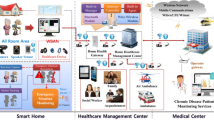Abstract
With the rapid growth of elderly population, ubiquitous healthcare (u-healthcare) service combined with advanced wireless networking technology is gaining popularity. The advance in medical sensor technology has boasted up the u-healthcare market potential. However, the global connectivity with a sufficient level of reliability is still an issue to study for its prototype development. In our previous study (Lee et al. In: Proc BodyNets 2010, Lee et al. in J Commun Netw 13(2):160–166, 2011), the energy efficient packet-level scheduling was studied but the scheduling and management topics in the access stratum, which is the beginning part of end-to-end connection for ubiquitous healthcare service, are still open. In this paper, we study an efficient and adaptive method that can provide u-healthcare user devices with an increased level of access privilege so that the healthcare related user data, which is sometimes delay-critical, can be more favorable admitted to the access stratum. We develop a mathematical formulation for the access control in access stratum domain over the existing 3.9-th generation cellular communication standard, called long term evolution (LTE) and devise an efficient and exact algorithm to solve it. The proposed method has simplicity in implementation and efficiency in operation. In addition, it can improve key performance measures, such as call blocking and call dropping performance.














Similar content being viewed by others
Notes
In this paper, a chunk of bits is said to be ‘decodable’ if no error is detected by a given error detection scheme.
The value c may vary depending on eNB’s. For the sake of expressional simplicity, we do not apply the cell index to c.
There are many different nodes/entities in the core network which provide their unique services and functions, such as mobility management, authentication, and so on. However, for the sake of simplicity, we will loosely say that this decision is made by eNB in this paper unless there is a confusing issue.
In our example, the ‘boundary point’ is exactly the adjacent point since there is only one unit available, if any, in the setting since the required volume is the same among different classes.
Abbreviations
- 3GPP:
-
3rd generation partnership project
- BAN:
-
Body area network
- BCU:
-
Body control unit
- BSU:
-
Body sensor unit
- DeNB:
-
Donor eNB
- eNB:
-
Evolved node B
- LTE:
-
Long term evolution
- MBAN:
-
Medical BAN
- MME:
-
Mobility management entity
- MMTEL:
-
Mobile multimedia telephony
- RAN:
-
Radio access network
- RN:
-
Relay node
- UE:
-
User equipment
- WBAN:
-
Wireless BAN
References
Kinsella, K., & Velkoff, V. A. (2001). An aging world. US Department of Health and Human Services and US Department of Commerce, November 2001.
Kailas, A., & Ingram, M. A. (2009). Wireless aspects of telehealth. Wireless Personal Communications, 51(4), 673–686.
Lee, K.-D., Kim, S., & Yi, B. K. (2010). Low power u-healthcare services using MDC packet-level scheduling for in/on-body wireless multi-hop links in a medical body area network. In Proceedings of BodyNets 2010, Corfu Island, Greece.
Lee, K.-D., Kim, S., & Yi, B. K. (2011). Packet-level scheduling for implant communications using forward error correction in an erasure correction mode for reliable u-healthcare service. Journal of Communication Network, 13(2), 160–166.
Chen, M., Gonzalez, S., Vasilakos, A., Cao, H., & Leung, V. (2010). Body area networks: A survey. ACM/Springer Mobile Networks and Applications, 16(2), 171–193.
Phunchongharn, P., Niyato, D., Hossain, E., & Camorlinga, S. (2010). An EMI-aware prioritized wireless access scheme for e-health applications in hospital environments. IEEE Transactions on Information Technology in Biomedicine, 14(5), 1247−1258.
Zhou, L., Zheng, B., Cui, J., & Geller, B. (2011). Media-aware distributed scheduling over wireless body sensor networks. In Proceedings of IEEE ICC’11, Kyoto, Japan.
Caceres, C., Fernandez, A., Ossowski, S., & Vasirani, M. (2009). Agent-based semantic service discovery for healthcare: An organizational approach. IEEE Intelligent Systems, 21(6), 11–20.
Lee, K.-D., & Yum, T.-S. P. (2011). On pareto-efficiency between profit and utility in OFDM resource allocation. IEEE Transactions on Communications, 58(11), 3277–3285.
IEEE 802.15 Wireless Personal Area Network. (2009). Channel model for body area network (BAN). IEEE 802.15-08-0780-09-0006.
Lee, K.-D., & Leung, V. (2009). Utility-based rate-controlled parallel wireless transmission of multimedia streams with multiple importance levels. IEEE Transactions on Mobile Computing, 8(1), 81–92.
3GPP TS 36.300. (2011). Evolved universal terrestrial radio access (E-UTRA) and evolved universal terrestrial radio access network (E-UTRAN); Overall description; Stage 2, v.10.3.0.
3GPP TR 36.912. (2010). Feasibility study for further advancements for E-UTRA (LTE-Advanced), v.9.3.0.
3GPP TS 36.304. (2011). Evolved universal terrestrial radio access (E-UTRA); user equipment (UE) procedures in idle mode. v.10.1.0.
3GPP TS 36.331. (2011). Evolved universal terrestrial radio access (E-UTRA); radio resource control (RRC); protocol specification. v.10.1.0.
Kim, S.-H., Chang, K.-N., & Kim, S. (2000). A channel allocation for cellular mobile radio systems using simulated annealing. Telecommunication Systems, 14, 95–106.
Lagrange, X., & Jabbari, B. (1998). Fairness in wireless microcellular networks. IEEE Transactions on Vehicle Technology, 47(2), 472–479.
Oh, S.-H., & Tcha, D. W. (1992). Prioritized channel assignment in a cellular radio network. IEEE Transactions on Communications, 40(7), 1259–1269.
Naghshineh, M., & Schwartz, M. (1996). Distributed call admission control in mobile/wireless networks. IEEE Journal of Selected Areas Communications 14, 289–293.
Takanashi, H., & Rappaport, S. S. (1997). Dynamic base station selection for personal communication systems with distributed control schemes. Proceedings of 47th VTC, 3, 1787−1791.
Author information
Authors and Affiliations
Corresponding author
Rights and permissions
About this article
Cite this article
Lee, KD., Vasilakos, A.V. Access stratum resource management for reliable u-healthcare service in LTE networks. Wireless Netw 17, 1667–1678 (2011). https://doi.org/10.1007/s11276-011-0371-6
Published:
Issue Date:
DOI: https://doi.org/10.1007/s11276-011-0371-6




